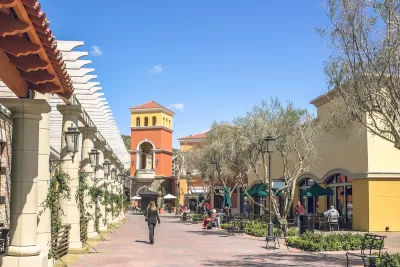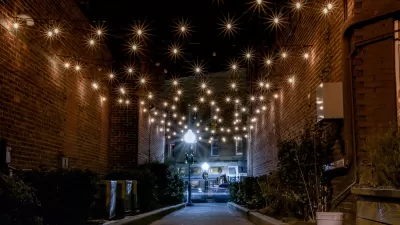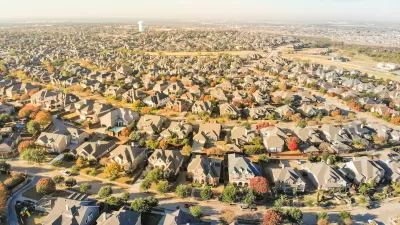Is the recent trend to build more walkable suburbs a sign of sustainable change?

Suburban developments are increasingly trying to mimic the walkability and vibrancy of urban neighborhoods, writes Alan Ehrenhalt in Governing. Is this a purely aesthetic shift, or is it a real movement toward more sustainable suburbs?
In Tempe, Arizona, 10 miles from Phoenix, a new community called Culdesac opted to remove private cars, offering access to transit, shared micromobility, and rental cars instead. According to Robert Steuteville, removing the need for car infrastructure inside the development “allows for a porous, fine-grain urban pattern with a network of narrow, shaded pedestrian-only paseos, intimate courtyards and a central plaza.” However, limited transit options mean that residents will often have to drive when leaving the community.
Ehrenhalt admits that the trend could be a blip. Lower housing costs — which could be brought on by the adaptive reuse of office buildings into residential units — could promote a stronger resurgence for urban city centers. But the strong demand for walkability among younger people is encouraging. “And if there is one thing we learned from the experience of the baby boomers, it is that when enough members of an emerging generation want something, they stand a very good chance of getting it.”
FULL STORY: A Possible Future for Downtowns Out in the Suburbs

Planetizen Federal Action Tracker
A weekly monitor of how Trump’s orders and actions are impacting planners and planning in America.

Congressman Proposes Bill to Rename DC Metro “Trump Train”
The Make Autorail Great Again Act would withhold federal funding to the system until the Washington Metropolitan Area Transit Authority (WMATA), rebrands as the Washington Metropolitan Authority for Greater Access (WMAGA).

The Simple Legislative Tool Transforming Vacant Downtowns
In California, Michigan and Georgia, an easy win is bringing dollars — and delight — back to city centers.

The States Losing Rural Delivery Rooms at an Alarming Pace
In some states, as few as 9% of rural hospitals still deliver babies. As a result, rising pre-term births, no adequate pre-term care and "harrowing" close calls are a growing reality.

The Small South Asian Republic Going all in on EVs
Thanks to one simple policy change less than five years ago, 65% of new cars in this Himalayan country are now electric.

DC Backpedals on Bike Lane Protection, Swaps Barriers for Paint
Citing aesthetic concerns, the city is removing the concrete barriers and flexposts that once separated Arizona Avenue cyclists from motor vehicles.
Urban Design for Planners 1: Software Tools
This six-course series explores essential urban design concepts using open source software and equips planners with the tools they need to participate fully in the urban design process.
Planning for Universal Design
Learn the tools for implementing Universal Design in planning regulations.
Smith Gee Studio
City of Charlotte
City of Camden Redevelopment Agency
City of Astoria
Transportation Research & Education Center (TREC) at Portland State University
US High Speed Rail Association
City of Camden Redevelopment Agency
Municipality of Princeton (NJ)





























